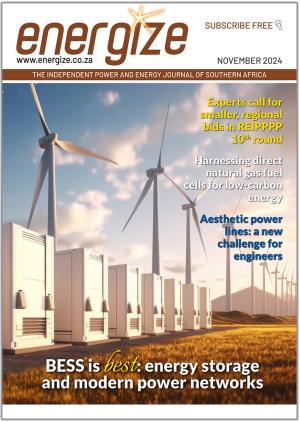Claiming this is a first for South Africa, Eskom has paved a coal ash geopolymer road at Kusile Power Station, showcasing innovative use of recycled coal ash as a sustainable alternative to traditional cement.
The 759 metre access road, unveiled at the power station in Mpumalanga yesterday, was developed by Eskom Rotek Industries using 2 904 tonnes of legacy coal ash per kilometre. It is designed to accommodate daily movement of 1 200-1 600 trucks each weighing approximately 34 tonnes. The trucks will be used in building a new coal conveyor belt at Kusile.
Construction of the road included geopolymerisation – a chemical process that converts aluminosilicate ash into geopolymer concrete. “By using this model, we’re replacing traditional cement with recycled ash and significantly reducing the carbon footprint. Every tonne of cement avoided means a direct reduction in carbon dioxide emissions,” said Kelley Reynolds-Clausen of Eskom’s Research, Testing and Development Division. Traditional cement production generates roughly one tonne of CO₂ per tonne of cement.
One of the technical highlights of the project is the use of plastic fibre reinforcement, which replaces conventional metal reinforcement and reduces construction costs by 90%. The road’s surface, or wearing course, is constructed from cementless concrete comprising a 200mm-thick layer of legacy ash (coal-fired power generation by-products such as weathered fly ash and bottom ash).
“We activate the ash with a small amount of slag – a waste product from the metal industry – and then allow it to set like traditional concrete,” said Reynolds-Clausen.
Beyond road infrastructure
Other applications of coal ash in infrastructure projects include manufacturing of bricks and other building materials, said Eskom’s Group Executive for Generation Bheki Nxumalo. “The use of our own ash not only mitigates environmental impacts but also creates new revenue streams for Eskom.”
Eskom plans to repurpose more of the 34 million tonnes of coal ash it produces annually. Currently, only 7-10% of this ash is beneficiated while the remainder is stored in ash disposal facilities.
Nxumalo also mentioned the future role of gypsum – another by-product Eskom intends to use. “We need to utilise this flue-gas desulfurisation product so that it becomes a revenue generator for Eskom and not just a cost.”
Eskom CEO Dan Marokane added: “This is not just an Eskom innovation; it’s a potential solution for infrastructure development across South Africa.”
Eskom is engaging with government agencies, including the Department of Human Settlements and the Department of Environmental Affairs, to reach communities in need of infrastructure development, he added.















